Xiaomin Wang
Boundary-enhanced time series data imputation with long-term dependency diffusion models
Jan 11, 2025



Abstract:Data imputation is crucial for addressing challenges posed by missing values in multivariate time series data across various fields, such as healthcare, traffic, and economics, and has garnered significant attention. Among various methods, diffusion model-based approaches show notable performance improvements. However, existing methods often cause disharmonious boundaries between missing and known regions and overlook long-range dependencies in missing data estimation, leading to suboptimal results. To address these issues, we propose a Diffusion-based time Series Data Imputation (DSDI) framework. We develop a weight-reducing injection strategy that incorporates the predicted values of missing points with reducing weights into the reverse diffusion process to mitigate boundary inconsistencies. Further, we introduce a multi-scale S4-based U-Net, which combines hierarchical information from different levels via multi-resolution integration to capture long-term dependencies. Experimental results demonstrate that our model outperforms existing imputation methods.
Channel Self-Supervision for Online Knowledge Distillation
Mar 23, 2022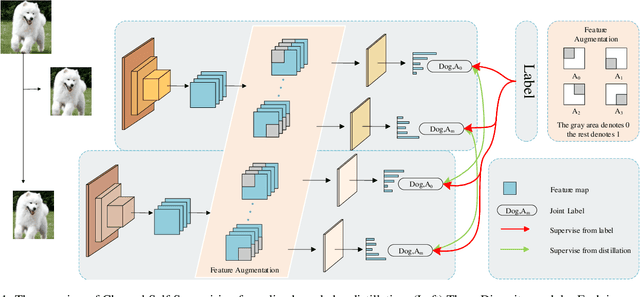

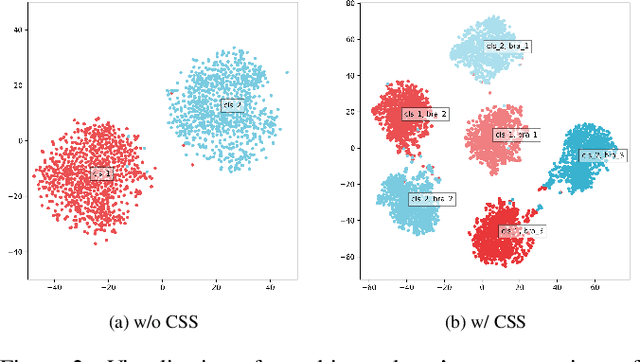

Abstract:Recently, researchers have shown an increased interest in the online knowledge distillation. Adopting an one-stage and end-to-end training fashion, online knowledge distillation uses aggregated intermediated predictions of multiple peer models for training. However, the absence of a powerful teacher model may result in the homogeneity problem between group peers, affecting the effectiveness of group distillation adversely. In this paper, we propose a novel online knowledge distillation method, \textbf{C}hannel \textbf{S}elf-\textbf{S}upervision for Online Knowledge Distillation (CSS), which structures diversity in terms of input, target, and network to alleviate the homogenization problem. Specifically, we construct a dual-network multi-branch structure and enhance inter-branch diversity through self-supervised learning, adopting the feature-level transformation and augmenting the corresponding labels. Meanwhile, the dual network structure has a larger space of independent parameters to resist the homogenization problem during distillation. Extensive quantitative experiments on CIFAR-100 illustrate that our method provides greater diversity than OKDDip and we also give pretty performance improvement, even over the state-of-the-art such as PCL. The results on three fine-grained datasets (StanfordDogs, StanfordCars, CUB-200-211) also show the significant generalization capability of our approach.
Temporally Resolution Decrement: Utilizing the Shape Consistency for Higher Computational Efficiency
Dec 02, 2021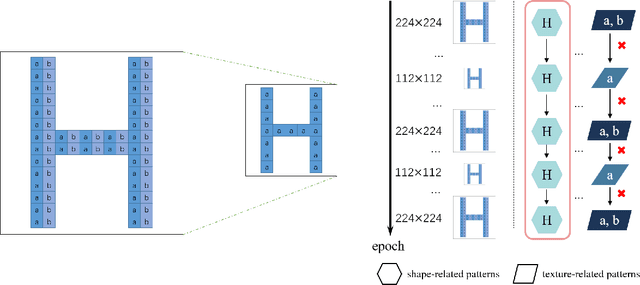
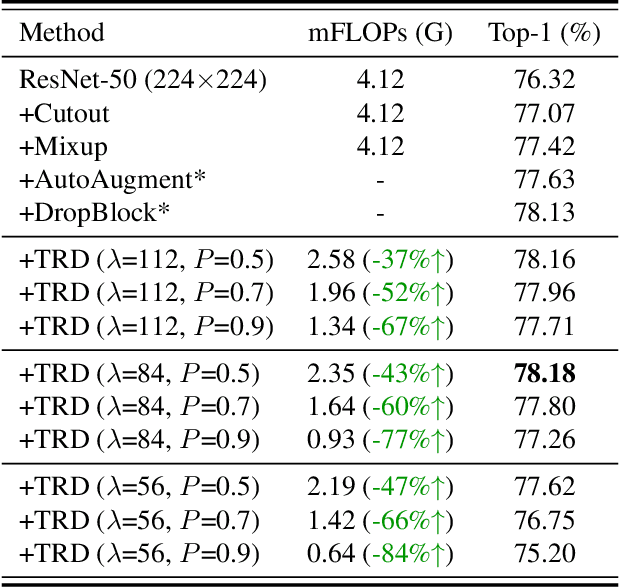
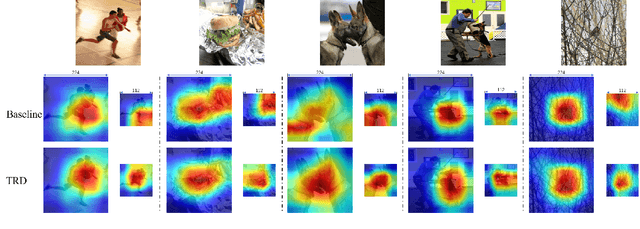
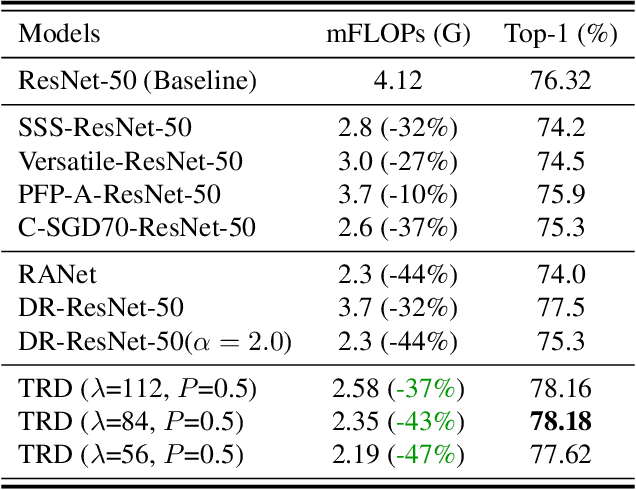
Abstract:Image resolution that has close relations with accuracy and computational cost plays a pivotal role in network training. In this paper, we observe that the reduced image retains relatively complete shape semantics but loses extensive texture information. Inspired by the consistency of the shape semantics as well as the fragility of the texture information, we propose a novel training strategy named Temporally Resolution Decrement. Wherein, we randomly reduce the training images to a smaller resolution in the time domain. During the alternate training with the reduced images and the original images, the unstable texture information in the images results in a weaker correlation between the texture-related patterns and the correct label, naturally enforcing the model to rely more on shape properties that are robust and conform to the human decision rule. Surprisingly, our approach greatly improves the computational efficiency of convolutional neural networks. On ImageNet classification, using only 33% calculation quantity (randomly reducing the training image to 112$\times$112 within 90% epochs) can still improve ResNet-50 from 76.32% to 77.71%, and using 63% calculation quantity (randomly reducing the training image to 112 x 112 within 50% epochs) can improve ResNet-50 to 78.18%.
Feature Mining: A Novel Training Strategy for Convolutional Neural Network
Jul 18, 2021



Abstract:In this paper, we propose a novel training strategy for convolutional neural network(CNN) named Feature Mining, that aims to strengthen the network's learning of the local feature. Through experiments, we find that semantic contained in different parts of the feature is different, while the network will inevitably lose the local information during feedforward propagation. In order to enhance the learning of local feature, Feature Mining divides the complete feature into two complementary parts and reuse these divided feature to make the network learn more local information, we call the two steps as feature segmentation and feature reusing. Feature Mining is a parameter-free method and has plug-and-play nature, and can be applied to any CNN models. Extensive experiments demonstrate the wide applicability, versatility, and compatibility of our method.
Go Small and Similar: A Simple Output Decay Brings Better Performance
Jun 12, 2021



Abstract:Regularization and data augmentation methods have been widely used and become increasingly indispensable in deep learning training. Researchers who devote themselves to this have considered various possibilities. But so far, there has been little discussion about regularizing outputs of the model. This paper begins with empirical observations that better performances are significantly associated with output distributions, that have smaller average values and variances. By audaciously assuming there is causality involved, we propose a novel regularization term, called Output Decay, that enforces the model to assign smaller and similar output values on each class. Though being counter-intuitive, such a small modification result in a remarkable improvement on performance. Extensive experiments demonstrate the wide applicability, versatility, and compatibility of Output Decay.
Self-supervision of Feature Transformation for Further Improving Supervised Learning
Jun 09, 2021



Abstract:Self-supervised learning, which benefits from automatically constructing labels through pre-designed pretext task, has recently been applied for strengthen supervised learning. Since previous self-supervised pretext tasks are based on input, they may incur huge additional training overhead. In this paper we find that features in CNNs can be also used for self-supervision. Thus we creatively design the \emph{feature-based pretext task} which requires only a small amount of additional training overhead. In our task we discard different particular regions of features, and then train the model to distinguish these different features. In order to fully apply our feature-based pretext task in supervised learning, we also propose a novel learning framework containing multi-classifiers for further improvement. Original labels will be expanded to joint labels via self-supervision of feature transformations. With more semantic information provided by our self-supervised tasks, this approach can train CNNs more effectively. Extensive experiments on various supervised learning tasks demonstrate the accuracy improvement and wide applicability of our method.
Self-supervised Feature Enhancement: Applying Internal Pretext Task to Supervised Learning
Jun 09, 2021



Abstract:Traditional self-supervised learning requires CNNs using external pretext tasks (i.e., image- or video-based tasks) to encode high-level semantic visual representations. In this paper, we show that feature transformations within CNNs can also be regarded as supervisory signals to construct the self-supervised task, called \emph{internal pretext task}. And such a task can be applied for the enhancement of supervised learning. Specifically, we first transform the internal feature maps by discarding different channels, and then define an additional internal pretext task to identify the discarded channels. CNNs are trained to predict the joint labels generated by the combination of self-supervised labels and original labels. By doing so, we let CNNs know which channels are missing while classifying in the hope to mine richer feature information. Extensive experiments show that our approach is effective on various models and datasets. And it's worth noting that we only incur negligible computational overhead. Furthermore, our approach can also be compatible with other methods to get better results.
White Paper Assistance: A Step Forward Beyond the Shortcut Learning
Jun 08, 2021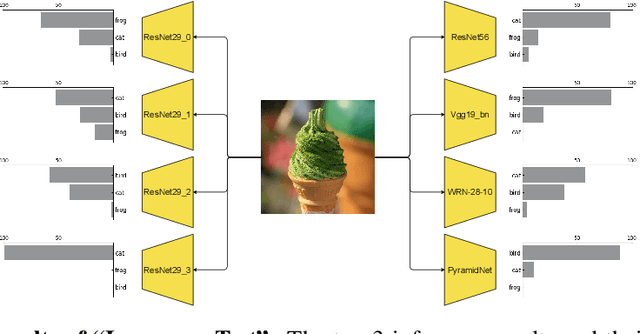
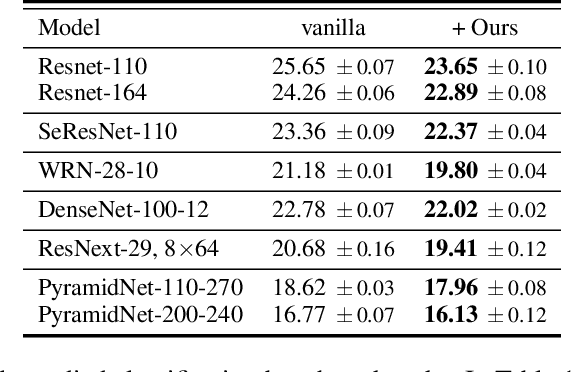

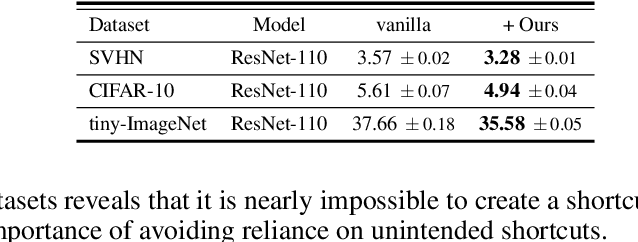
Abstract:The promising performances of CNNs often overshadow the need to examine whether they are doing in the way we are actually interested. We show through experiments that even over-parameterized models would still solve a dataset by recklessly leveraging spurious correlations, or so-called 'shortcuts'. To combat with this unintended propensity, we borrow the idea of printer test page and propose a novel approach called White Paper Assistance. Our proposed method involves the white paper to detect the extent to which the model has preference for certain characterized patterns and alleviates it by forcing the model to make a random guess on the white paper. We show the consistent accuracy improvements that are manifest in various architectures, datasets and combinations with other techniques. Experiments have also demonstrated the versatility of our approach on fine-grained recognition, imbalanced classification and robustness to corruptions.
FocusedDropout for Convolutional Neural Network
Mar 29, 2021



Abstract:In convolutional neural network (CNN), dropout cannot work well because dropped information is not entirely obscured in convolutional layers where features are correlated spatially. Except randomly discarding regions or channels, many approaches try to overcome this defect by dropping influential units. In this paper, we propose a non-random dropout method named FocusedDropout, aiming to make the network focus more on the target. In FocusedDropout, we use a simple but effective way to search for the target-related features, retain these features and discard others, which is contrary to the existing methods. We found that this novel method can improve network performance by making the network more target-focused. Besides, increasing the weight decay while using FocusedDropout can avoid the overfitting and increase accuracy. Experimental results show that even a slight cost, 10\% of batches employing FocusedDropout, can produce a nice performance boost over the baselines on multiple datasets of classification, including CIFAR10, CIFAR100, Tiny Imagenet, and has a good versatility for different CNN models.
Selective Output Smoothing Regularization: Regularize Neural Networks by Softening Output Distributions
Mar 29, 2021



Abstract:In this paper, we propose Selective Output Smoothing Regularization, a novel regularization method for training the Convolutional Neural Networks (CNNs). Inspired by the diverse effects on training from different samples, Selective Output Smoothing Regularization improves the performance by encouraging the model to produce equal logits on incorrect classes when dealing with samples that the model classifies correctly and over-confidently. This plug-and-play regularization method can be conveniently incorporated into almost any CNN-based project without extra hassle. Extensive experiments have shown that Selective Output Smoothing Regularization consistently achieves significant improvement in image classification benchmarks, such as CIFAR-100, Tiny ImageNet, ImageNet, and CUB-200-2011. Particularly, our method obtains 77.30$\%$ accuracy on ImageNet with ResNet-50, which gains 1.1$\%$ than baseline (76.2$\%$). We also empirically demonstrate the ability of our method to make further improvements when combining with other widely used regularization techniques. On Pascal detection, using the SOSR-trained ImageNet classifier as the pretrained model leads to better detection performances. Moreover, we demonstrate the effectiveness of our method in small sample size problem and imbalanced dataset problem.
 Add to Chrome
Add to Chrome Add to Firefox
Add to Firefox Add to Edge
Add to Edge